Following an announcement from American Airlines yesterday (July 14), all three of the biggest US customers for Boeing’s 737 Max, grounded since a second deadly crash in March, have removed the aircraft from their schedules until the last quarter of the year.
The carrier said that it was removing the Max from its schedules until Nov. 2, which will mean 115 canceled flights a day as it diverts other aircraft to its busiest routes. It said it was still confident the plane would be re-certified by the US Federal Aviation Administration (FAA) this year. Its statement followed a similar announcement from United last week, while Southwest Airlines in late June removed the plane from its calendar until Oct. 1.
The Wall Street Journal, however, today cited industry experts and government officials as saying the grounding could stretch into 2020 (paywall) because of expanded safety checks of the plane, and the technical complexity of the process.
Boeing has been working on software changes to how its Maneuvering Characteristic Augmentation System (MCAS) works since last year, when the Max saw its first deadly accident with the crash of a Lion Air flight in October in Indonesia, killing all 189 people on board. In March, 157 people died on board an Ethiopian Airlines flight. MCAS was implicated in both crashes, according to preliminary air-crash investigation reports. Designed to protect against a stall, the system pushed the nose of the planes sharply downward in both cases, and pilots were unable to stabilize the planes.
An FAA official on June 12 predicted at an aviation conference in Europe that Boeing’s 737 Max would fly again in December. Two weeks later Boeing announced it was going to work on an additional software fix the FAA is requiring, which is related to the emergency response that pilots need to carry out in the event of the MCAS triggering erroneously.
Given the delays with the main software fix—at one time the FAA had said it expected to order airlines to deploy the software change “no later than April“—it’s unclear how the need for the additional software update will affect the timeline of the Max’s return to service. A Wall Street Journal report (paywall) last month noted the software update may not be sufficient to address the problem, in which case a hardware change could be required on the planes.
Boeing said the final determination of when the plane will return to service depends on regulators.
“We have said all along that the regulatory authorities determine the process for certifying the MAX software and training updates and the timing for lifting the grounding order,” said Boeing in a statement. “With safety as our top priority, we are continuing to work with the FAA and other regulators to complete as many elements of the certification process as possible in parallel with the development of the software update.”
It added that the final software package will be submitted to the FAA once Boeing has satisfied all the regulator’s certification requirements.
Even if the plane is re-certified in the last months of the year, it’s unclear that passengers spooked by the plane will welcome its return right ahead of the Christmas and New Year holiday seasons. Airlines also need to complete maintenance procedures required for restoring planes that have been in storage to service.
Current estimates are that 45 days will be required from the time the FAA issues an airworthiness directive for the Max to cover updates to the system and pilot training, according to a representative for the Southwest Airlines Pilots Association, the carrier’s pilots’ union, Southwest Airlines. Accordingly, the FAA would have to issue such an order by early November for the plane to fly again this year.
Meanwhile Europe’s aviation regulator is proceeding with an abundance of caution, and has said it will independently review and approve design changes to the Max, rather than relying largely on the FAA process to decide when the plane can fly again.
The FAA said at the time of the Boeing announcement on the need for an additional software fix that it is “following a thorough process, not a prescribed timeline, for returning the Boeing 737 Max to passenger service. The FAA will lift the aircraft’s prohibition order when we deem it is safe to do so.”
Update: The story was updated on the day of publication with comment from Boeing. It was also updated on July 16 with a statement from SWAPA.
Looking for more in-depth coverage of Boeing? Sign up for a free trial of Quartz membership, and read our premium field guide on Boeing’s current crisis.
